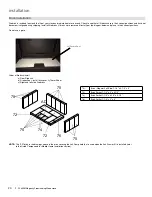
F2450M Regency Freestanding Woodstove
|
25
operating instructions
Whether you burn wood in a fireplace, stove or insert,
good quality firewood is the key to convenience, ef-
ficiency and safety. Wet wood and pieces that are not
the right size and shape for your wood burner can
be frustrating, burn inefficiently and deposit creosote
that can fuel a dangerous chimney fire. Good plan-
ning, seasoning and storage of the firewood supply
are essential to successful wood burning.
•
Stack the wood in separate rows in an
open location where the summer sun can
warm it and breezes can carry away the
moisture. Do not stack unseasoned wood
tightly in an unvented storage area.
•
Do not allow firewood to lie on the ground
for more than a couple of days before
stacking. Mould and rot can set in quickly.
•
Stack the wood up off the ground on poles,
lumber rails or pallets.
•
The top of the pile can be covered to keep
off rain, but do not cover the sides.
Softer woods like pine, spruce and poplar/aspen that
is cut, split and stacked properly in the early spring
maybe be ready for burning in the fall. Extremely
hard woods like oak and maple, and large pieces
of firewood, may take a minimum of a full year to
dry enough. Drying may also take longer in damp
climates.
There are a few ways to tell if wood is dry enough to
burn efficiently. Use as many indicators as possible
to judge the dryness of the firewood your are con-
sidering. Here are ways to judge firewood moisture.
•
Using a moisture meter, select the species
of fuel and then penetrate the pins into a
split piece. Ideal moisture and seasoned
firewood should be less than 20% mois-
ture content.
•
Checks or cracks in the end grain can
be an indication of dryness, but may not
be a reliable indicator. Some wet wood
has checks and some dry wood has no
checks.
•
The wood tends to darken from white or
cream colour to grey or yellow as it dries.
•
Two dry pieces banged together sound
hollow; wet pieces sound solid and dull.
•
Dry wood weighs much less than wet
wood.
•
Split a piece of wood. If the exposed
surface feels damp, the wood is too wet
to burn.
Seasoned Firewood
WARNING: To build a fire in igno-
rance or to disregard the information
contained in this section can cause
serious permanent damage to the unit
and void your warranty!!
Operating
Instructions
With your unit now correctly installed and safety
inspected by your local authority, you are now ready
to start a fire. Before establishing your first fire, it
is important that you fully understand the operation
of your draft control.
WARNING
Fireplace Stoves equipped with doors
should be operated only with doors fully
closed. If doors are left partly open, gas
and flame may be drawn out of the fireplace
stove opening, creating risks from both
fire and smoke.
Left - Open Right - Closed
Primary Air Damper
Draft Control
Both the primary and air wash drafts are controlled
by the control slide located on the front left side of
the unit, below the ashlip (when facing the unit). To
increase your draft - slide to the left to open, and to
decrease - slide to the right to close. The F2450M
unit has a secondary draft system that continually
allows combustion air to the induction ports at the
top of the firebox.
Draft is the force which moves air from the ap-
pliance up through the chimney. The amount of
draft in your chimney depends on the length of
the chimney, local geography, nearby obstruc-
tions and other factors. Too much draft may
cause excessive temperatures in the appliance.
Inadequate draft may cause back puffing into the
room and plugging of the chimney.
















































